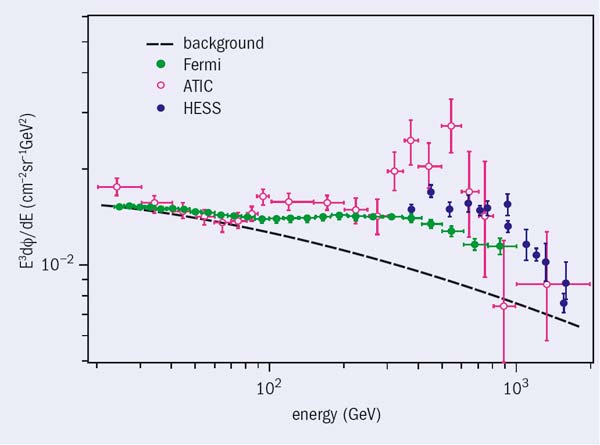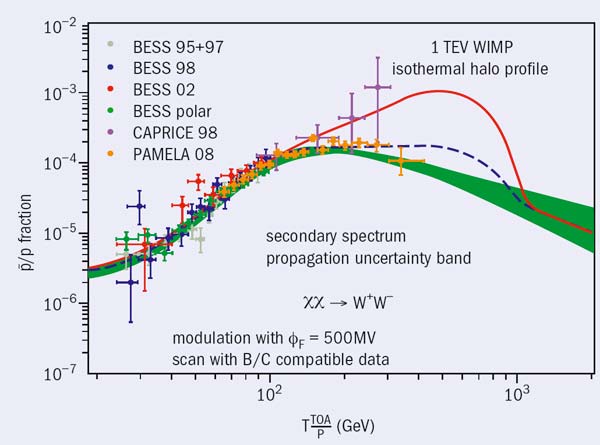Recent data favour an astrophysical explanation for cosmic-ray features.

Recent measurements of cosmic-ray leptons – electrons and positrons – have generated a buzz because they might point to unknown astrophysical or exotic cosmic phenomena. A new measurement of the cosmic-ray positron fraction, e+/(e–+e+), by the satellite-borne PAMELA detector shows an unambiguous rise between 10 GeV and 100 GeV. This confirms previous claims by the High-Energy Antimatter Telescope (HEAT) and AMS-01 collaborations (figure 1). At the same time, the Advanced Thin Ionization Calorimeter (ATIC), Fermi Gamma-Ray Telescope and HESS collaborations have published new results on the sum e–+e+ at higher energies, up to a few tera-electron-volts. Although there are still discrepancies between these three experiments they could indicate the presence of a feature in the energy spectrum of e–+e+ between 600 GeV and 1 TeV. Whether it is a bold peak, as ATIC claims, or a more shy bump, as the Fermi data indicate, is still unclear (figure 2). Further work and crosschecks are necessary to reach a definite answer. Another issue concerns whether this feature arises from electrons only or from both electrons and positrons.

There is nevertheless the hint of a signal in this energy range, which is quite challenging to reproduce with conventional cosmic-ray models. A workshop held in Paris in May, “Testing Astroparticle with the New GeV/TeV Observations. Positrons And electRons: Identifying the Sources (TANGO in PARIS)”, provided the opportunity to discuss and confront the possible interpretations of these results.
Conventional cosmic-ray production
The current understanding is that most cosmic rays are produced in the remnants of supernovae – what is left after the cataclysmic ends to the lives of many stars. Some cosmic-ray species (positrons, antiprotons, boron etc.) do not exist in stars but are instead produced by the spallation reaction of other cosmic rays with the interstellar medium. Once made, cosmic rays diffuse in the galactic magnetic field; they lose energy, are convected and eventually reach Earth.
Even taking into account the uncertainties underlying the state-of-the-art cosmic-ray transport modelling it is not possible to reproduce the PAMELA data, as figure 1 shows (T Delahaye et al. 2009). One solution is that the model for standard astrophysical positrons is mistaken in some way. For instance, the source distribution in the galaxy might be more complex than generally believed and positron production by spallating proton cosmic-rays on interstellar matter might be higher than expected. Such an effect could arise from a local over-density of proton sources (the spiral arms) or of interstellar matter around supernova remnants. However, in these models, it is difficult at the same time not to over-produce other cosmic-ray species, such as antiprotons or boron.

Another solution is that supernovae and spallating cosmic rays are not alone in the significant production of high-energy charged particles, so that other astrophysical objects also contribute. As electrons and positrons lose a lot of energy as they propagate in the galaxy, one single nearby source could explain the observed feature. Pulsars seem to be a good candidate for such an effect because they may produce electrons and positrons evenly, thus enriching the surrounding positron fraction. Unfortunately, the way that pulsars could produce electron–positron pairs and release them in the galaxy is not yet clear – making predictions difficult. Nevertheless, recent observations from Fermi have revealed that pulsars are more numerous than expected, so there is a high chance that we are missing many of them. Hence explaining the PAMELA/ATIC feature with pulsars is feasible.
The most exciting solution would be that these excesses arise from the effects of dark matter, so allowing a first insight into physics beyond the Standard Model. Indeed, in such a scenario, the mass of our galaxy would be dominated by new non-standard particles, which would annihilate or decay into standard particles, contributing to the cosmic-ray flux.
While it is extremely appealing, the dark-matter solution is puzzling. The natural way to agree with constraints from cosmology (freeze-out of the dark-matter particles in the early universe) is to have a new particle with mass and couplings of the order of the electroweak scale. If this particle could annihilate or decay into Standard Model particles then the corresponding cosmic-ray production rate would be small, which would not allow the reproduction of features as significant as the ones seen by PAMELA, ATIC, Fermi and HESS. To account for them, the dark-matter signal must be magnified with respect to the standard picture in some way, by a factor ranging from 100 to 1000, depending on the model. This is a well known fact – which the models make possible either with some particle-physics effect (for dark-matter particles of masses typically larger than a few tera-electron-volts or so) or as a consequence of local enhancements of the signal caused by dark-matter substructures.
Trouble appears when confronting this interpretation with channels where corresponding excesses should appear, such as cosmic antiprotons and photons. PAMELA recently published fresh measurements of the antiproton flux up to 100 GeV (figure 3), which show no specific feature. Antiprotons are interesting because the theoretical uncertainty associated with the background estimate is lower than for that of positrons – and most models with new physics expect annihilations or decays of dark matter to produce antiprotons. It is therefore possible to put an upper limit to the signal enhancement necessary to explain the leptonic data (Donato et al. 2009). It eventually appears that the antiproton data are incompatible with the large enhancements that are required by leptons for conventional dark-matter candidates.
The only way out is to have either a very heavy particle (of mass larger than 10 TeV) or to suppress the hadronic annihilation or decay modes of the dark-matter particle. In the first case, an excess of antiprotons should appear in future higher-energy data; in the second, no hadrons are produced by this so-called “leptophilic” dark matter. In both cases the properties of the new particle are different from those usually expected. Within minimal supersymmetric dark-matter models, for instance, large masses imply a loss of naturalness and direct electron/positron production in the annihilation is suppressed. In addition, when confronting models that survive the antiproton constraints to photon observations, the net tightens even more. Indeed, all of these electrons and positrons should also be produced in places where large magnetic fields are present (e.g. at the galactic centre) and consequently produce sizable radio emission, which is in general above the measured values (at least in the most standard galactic models).
The previous considerations assume a particle-physics type enhancement – i.e. an overall enhancement of the production of exotic cosmic leptons – regardless of the location in the galaxy. However, one could ask if these cosmic-ray features are the same everywhere in the galaxy. An interesting possibility is that a nearby clump of dark matter is responsible for some local excesses (Brun et al. 2009). In this case, the antiproton constraints may be less stringent and the ones from photon observations are totally avoided. The main feature responsible for the local lepton anomalies would then be a nearby (closer than a few kiloparsecs), bright clump. (As electrons and positrons do not propagate over large distances, just one massive clump could contribute sufficiently). In fact, dark-matter haloes are expected to form by successive mergers of small structures. Large haloes, such as the one of our galaxy, should contain a lot of smaller subhaloes (up to 20% of the total halo mass). Large numerical simulations can model the formation of these structures and calculate the probability of finding a configuration that fulfils the requirements to account for the lepton excesses in a halo of the size of the Milky Way. Unfortunately, this probability is found to be extremely low; usually fewer than 1% of the simulations exhibit such a favourable scenario. If such a clump does exist, however, the gamma-ray satellite Fermi has enough sensitivity to detect the associated gamma-ray emission.
Epilogue?

It is definitely possible to reproduce the observed cosmic-ray data with the help of dark-matter signals. Within this hypothesis, however, there will always be some tension between the different channels and observables or quite a high level of fine tuning. It could be that we are circling the properties of dark-matter particles but it is more likely that the bulk of the observed leptons come from a nearby astrophysical source that produces a large fraction of electron–positron pairs. In this case, the signal would constitute an additional background for indirect searches for dark matter through lepton channels that had not previously been accounted for.
A big step forward will be the measurement of the small anisotropy in the arrival directions of the cosmic-ray leptons, if any. If it is observed and points towards a known pulsar, then the conclusion will be clear. It is also urgent to separate electrons from positrons at higher energies and to increase statistics in all channels. Future results from PAMELA, and especially AMS-02, on leptons and also on fluxes of all nuclei will be of great help in feeding the cosmic-ray propagation models. The indirect searches for dark matter through charged channels can then continue, in particular looking for fine structure in the spectra. It will then be interesting (and challenging) to interpret future data and weigh them against results from the LHC and direct-detection experiments.
Whatever the nature of the source, we might be witnessing the first direct observation of a nearby source of cosmic rays with energies in the range of giga- to tera-electron-volts. These are exciting times and we might have to wait a little longer for the solution to this cosmic puzzle. The answer(s) will certainly come from a convergence of information from different messengers. Thanks to its large field of view, the Fermi telescope should reveal something about a nearby source, should it be a pulsar or something more exotic. Eventually, future large neutrino and gamma-ray observatories (such as KM3NeT and the Cherenkov Telescope Array) will certainly offer a great opportunity to take a deeper look into this brainteaser.
• The presentations slides and videos the TANGO talks are available at http://irfu.cea.fr/Meetings/TANGOinPARIS.





